

Chem. J. Chinese Universities ›› 2023, Vol. 44 ›› Issue (5): 20220717.doi: 10.7503/cjcu20220717
• Review • Previous Articles Next Articles
ZHANG Xiaoran1, ZHENG Jianyun1( ), LYU Yanhong1,2(
), LYU Yanhong1,2( ), WANG Shuangyin1(
), WANG Shuangyin1( )
)
Received:2022-11-14
Online:2023-05-10
Published:2023-01-03
Contact:
ZHENG Jianyun, LYU Yanhong, WANG Shuangyin
E-mail:jyzheng@hnu.edu.cn;lvyanhong603@163.com;shuangyinwang@hnu.edu.cn
Supported by:CLC Number:
TrendMD:
ZHANG Xiaoran, ZHENG Jianyun, LYU Yanhong, WANG Shuangyin. Recent Advances in Green C-N Coupling for Urea Synthesis[J]. Chem. J. Chinese Universities, 2023, 44(5): 20220717.
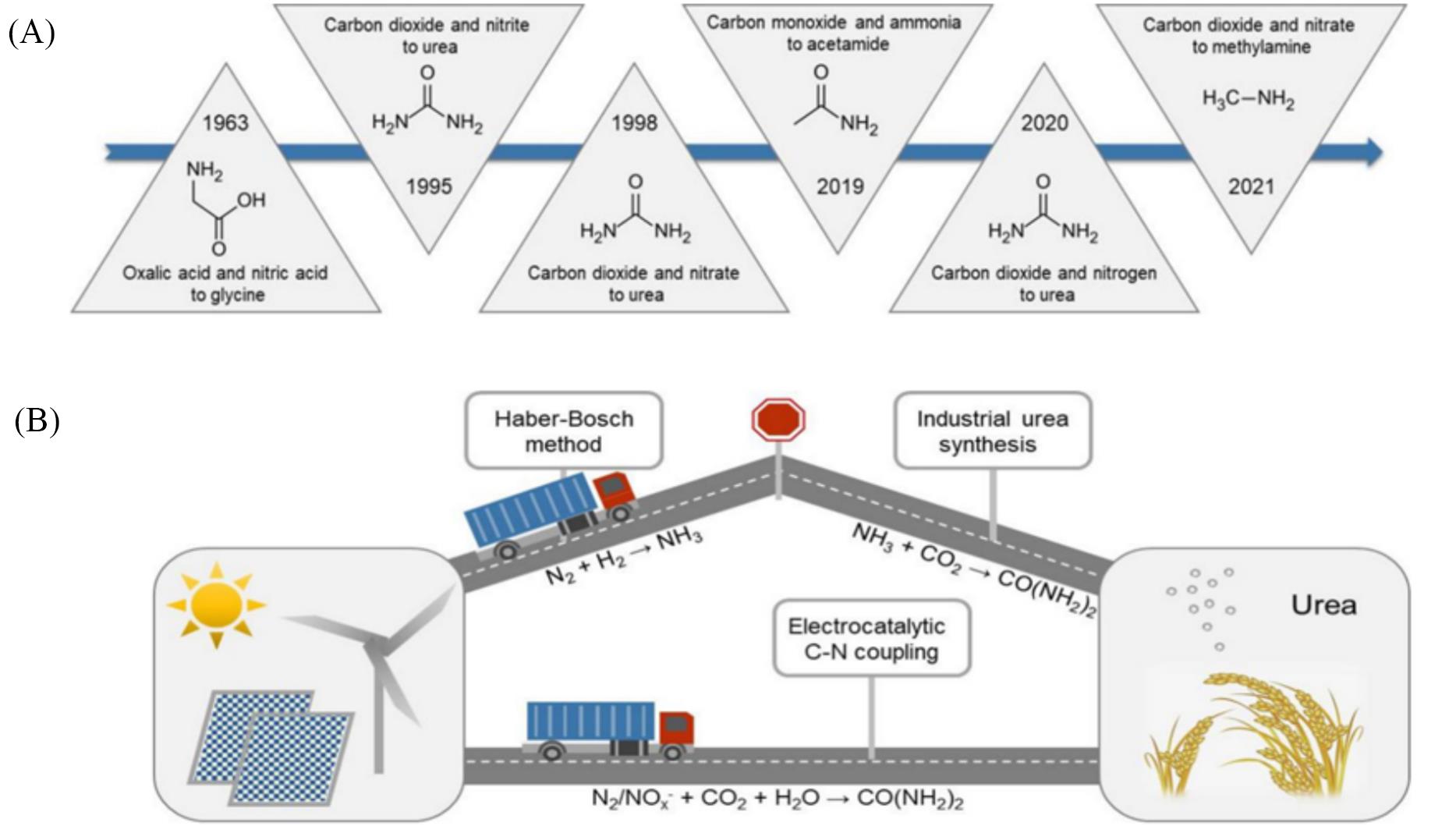
Fig.1 Progress of C⁃N coupling reactions for electrocatalytic amine synthesis(A) and pathways to urea synthesis(B)[10](A) Haber-Bosch method combined with industrial urea synthesis; (B) direct electrocatalytic C-N coupling process.
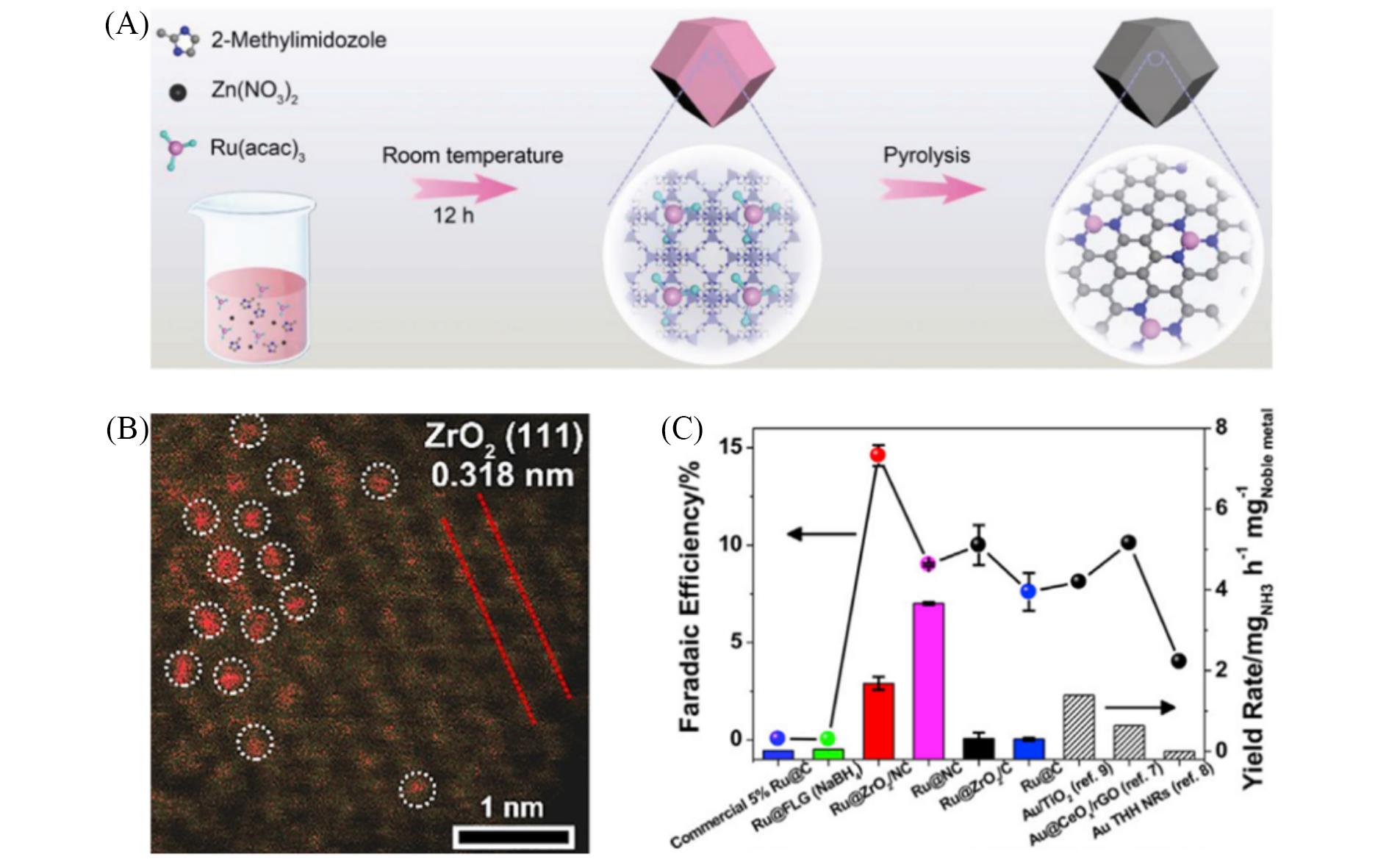
Fig.3 Synthesis schematic diagram of single⁃atom ruthenium catalyst(A)[44], scanning transmission electron microscope photo of ruthenium single⁃atom catalyst containing zirconia(B)[61], electrocatalytic nitrogen reduction performance of single⁃atom ruthenium catalyst containing zirconia and performance comparison with other catalysts(C)[62](A) Copyright 2018, Wiley-VCH; (B) Copyright 2019, Elsevier; (C) Copyright 2019, Springer Nature.
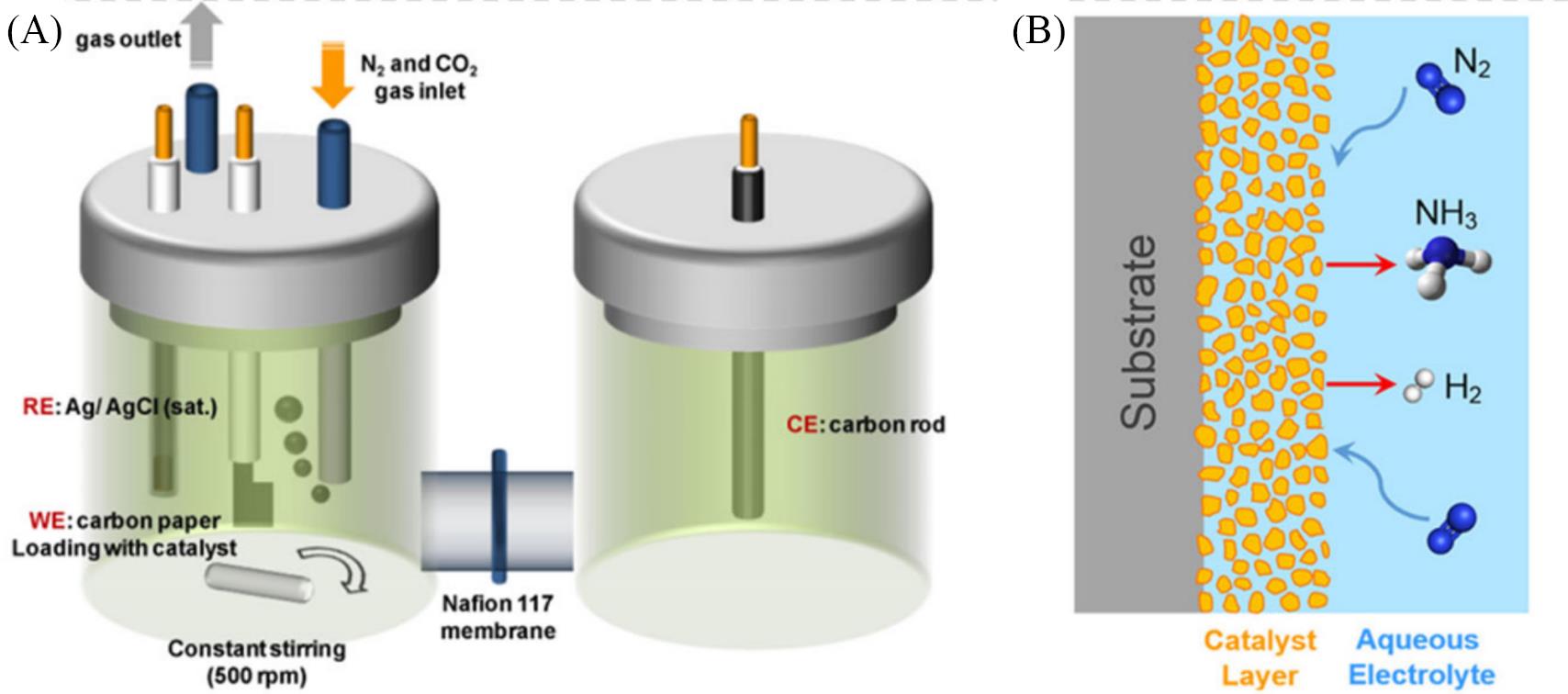
Fig.4 Optimization of catalytic system for urea synthesis(A) The typical H cell for urea electrocatalytic synthesis; (B) schematic illustration of solid-liquid interface in H cell[65].Copyright 2020, American Chemical Society.
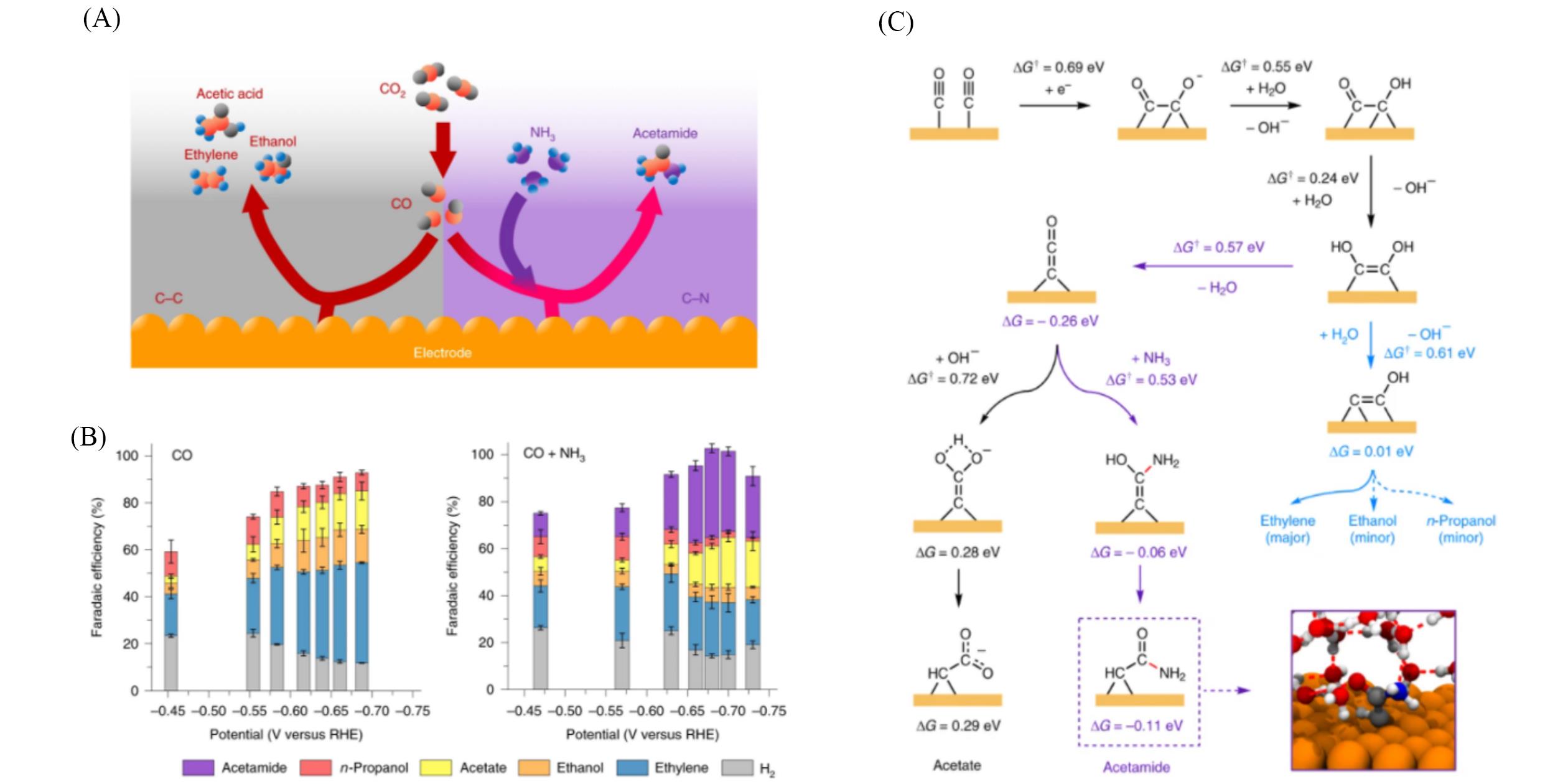
Fig.5 Schematic diagram of the formation of carbon⁃nitrogen bonds induced by introducing ammonia gas in the electrocatalytic reduction reaction of carbon monoxide(A), Faradaic efficiency of each product obtained by co⁃electrolysis of carbon monoxide and ammonia gas(B), co⁃electrolysis of carbon monoxide and ammonia gas, the mechanism diagram of each product and the energy barrier obtained by theoretical calculation of each step reaction(C)[66]
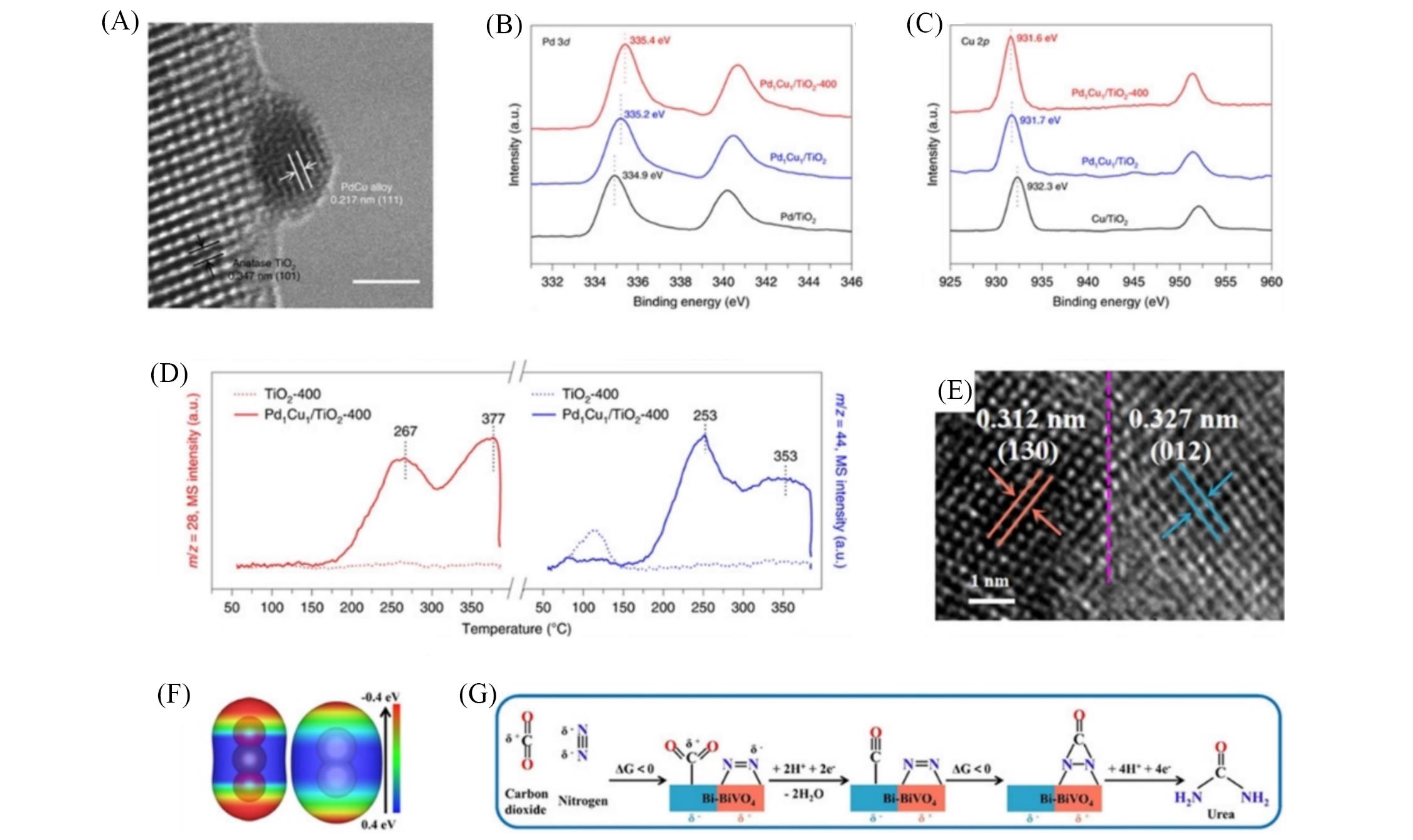
Fig.6 Design of electrocatalysts for coupling of nitrogen and carbon dioxide for urea synthesis(A) High-resolution TEM image of PdCu/TiO2-400 catalyst; (B) Pd3d XPS spectra of Pd/TiO2, PdCu/TiO2, and PdCu/TiO2-400; (C) Cu2p XPS spectra of Cu/TiO2, PdCu/TiO2 and PdCu/TiO2-400; (D) competitive chemisorption of nitrogen and carbon dioxide on TiO2-400 and PdCu/TiO2-400[45]; (E) high-resolution TEM image of Bi/BiVO4 hybrid; (F) electron density isosurface of carbon dioxide and nitrogen molecules; (G) the proposed reaction pathway of urea formation on Bi/BiVO4 hybrid, the urea yield rate[71].
| 1 | Zhu D. D., Liu J. L., Qiao S. Z., Adv. Mater., 2016, 28(18), 3423—3452 |
| 2 | Sun Z., Ma T., Tao H., Fan Q., Han B. X., Chem, 2017, 3(4), 560—587 |
| 3 | Chen X., Guo Y., Du X., Adv. Energy Mater., 2019, 10(3), 1903172 |
| 4 | Seh Z. W., Kibsgaard J., Dickens C. F., Science, 2017, 355(6321), eaad4998 |
| 5 | Gao S., Lin Y., Jiao X., Li D. Q., Yang J. L., Xie Y., Nature, 2016, 529(7584), 68—71 |
| 6 | Kim C., Jeon H. S., Eom T., Min B., Hwang J., J. Am. Chem. Soc., 2015, 137(43), 13844—13850 |
| 7 | Wu J., Yadav R. M., Liu M., Zou A. L., Zhou X. D., Yakobson B. I., Lou J., Pulickel M. A., ACS Nano, 2015, 9(5), 5364—5371 |
| 8 | Cao Z., Kim D., Hong D. A., Wen X. D., Nichols E. M, Keunhong J., Jeffrey A. R., Yang P. D., Christopher J. C., J. Am. Chem. Soc., 2016, 138(26), 8120—8125 |
| 9 | Rosen J., Hutchings G. S., Lu Q., ACS Catal., 2015, 5(7), 4293—4299 |
| 10 | Chen C., He N. H., Wang S. Y., Small Sci., 2021, 1, 2100070 |
| 11 | Comer B. M., Fuentes P., Dimkpa C. O., Joule, 2019, 3(7), 1578—1605 |
| 12 | Service R. F., Science, 2014, 345(6197), 610 |
| 13 | Martín A. J., Shinagawa T., Pérez⁃Ramírez J., Chem, 2019, 5(2), 263—283 |
| 14 | Yan D., Li H., Chen C., Xie C., Zou Y. Q., Wang S. Y., Small Methods, 2018, 3(6), 1800331 |
| 15 | Guo C., Ran J., Vasileff A., Energy Environ. Sci., 2018, 11(1), 45—56 |
| 16 | Licht S., Cui B., Wang B., Science, 2014, 345(6197), 637—640 |
| 17 | Soloveichik G., Nat. Catal., 2019, 2(5), 377—380 |
| 18 | Jiao F., Xu B. J., Adv. Mater., 2019, 31, 1805173 |
| 19 | Tao L., Wang Y., Zou Y., Che W., Chen C., Zheng J. Y., Lyu Y. H., Wang S. Y., Adv. Energy Mater., 2019, 10(11), 1901227 |
| 20 | Wang J., Yu L., Hu L., Nat. Commun., 2018, 9(1), 1795 |
| 21 | Mo R. C., Zhang X. R., Chen Z. Y., Huang S. L., Li Y. J., Liang L. Z., Tian Z. Q., Shen P. K., Int. J. Hydrog. Energy, 2021, 46, 15991—16002 |
| 22 | Scher H. D., Geisz J. F., Deutsch T. G., Turner J. A., Energy Environ. Sci., 2014, 7, 2951—2956 |
| 23 | Jin J., Walczak K., Singh M. R., Karp C., Energy Environ. Sci., 2014, 7, 3371—3380 |
| 24 | Bae D., Seger B., Vesborg P. C., Hanse O., Chorkendorff I., Chem. Soc. Rev., 2017, 46, 1933—1954 |
| 25 | Shen S., Lindley S. A., Chen X., Zhang J. Z., Energy Environ. Sci., 2016, 9, 2744—2775 |
| 26 | White J. L., Baruch M. F., Pander J. E., Hu Y., Fortmeyer I. C., Park J. E., Chem. Rev., 2015, 115, 12888—12935 |
| 27 | Zhang X. R., Zhu X. R., Bo S. W., Chen C., Qiu M. Y., Wei X. X., Chen W., Zheng J. Y., Jiang S. P., Wang S. Y., 2022, Nat. Commun., 13, 5337 |
| 28 | Lv C., Lee C., Zhong L. X., Liu H. J., Liu J. W., Yang L., Yan C. S., Yan Q. Y., Yu G. H., Sci. Adv., 2019, 5(1), eaat5778 |
| 29 | Wei M., Huang L., Huang S. L., Chen Z. Y., Lyu D. D., Zhang X. R., Wang S. B., Tian Z. Q., Shen P. K., J. Catal., 2020, 381, 385—394 |
| 30 | Zhao Y. X., Zhao Y. F., Shi R., Wang B., Geoffrey I. N., Wu L. Z., Tung C. H., Zhang T. R., Adv. Mater., 2019 , 31, 1806482 |
| 31 | Hirakawa H., Hashimoto M., Shiraishi Y., Hirai T., J. Am. Chem. Soc., 2017, 139, 10929 |
| 32 | Liu G., Zhao Y., Sun C., Li F., Lu G. Q., Cheng M. H., Angew. Chem. Int. Ed., 2008, 47, 4516 |
| 33 | Wang S., Hai X., Ding X., Chang K., Xiang Y., Meng X., Yang Z., Chen H., Ye J., Adv. Mater., 2017, 29, 1701774 |
| 34 | Kumari S., Pishgar S., Schwarting M. E., Chem. Commun., 2018, 54(95), 13347—13350 |
| 35 | Iwamoto M., Akiyama M., Aihara K., ACS Catal., 2017, 7(10), 6924—6929 |
| 36 | Xin X., Xu T., Yin J., Wang L., Wang C., Appl. Catal. B, 2015, 354, 176—177 |
| 37 | Mcenaney J. M., Singh A. R., Schwalbe J. A., Energy Environ. Sci., 2017, 10(7), 1621—1630 |
| 38 | Hawtof R., Ghosh S., Guarr E., Sci. Adv., 2019, 5(1), eaat5778 |
| 39 | Chen J. G., Crooks R. M., Seefeldt L. C., Science, 2018, 360(6391), eaar6611 |
| 40 | Erisman J. W., Sutton M. A., Nat. Geosci., 2008, 1(10), 636—639 |
| 41 | Li S. Q., Wang Y. N., Du Y., Zhu X. D., Gao J., Zhang Y. C., Wu G., Small, 2023, 2206776 |
| 42 | Ma J. L., Bao D., Shi M. M., Chem, 2017, 2(4), 525—532 |
| 43 | Lazouski N., Schiffer Z. J., Williams K., Joule, 2019, 3(4), 1127—1139 |
| 44 | Geng Z., Liu Y., Kong X., Miao S., Si R., Zeng J., Adv. Mater., 2018, 1803498 |
| 45 | Chen C., Zhu X., Nat. Chem., 2020, 12, 717—724 |
| 46 | Yan D., Li Y., Huo J., Chen R., Dai L. M., Wang S. Y., Adv. Mater., 2017, 29(48), 1606459 |
| 47 | Cao N., Zheng G., Nano Res., 2018, 11(6), 2992—3008 |
| 48 | Wang M., Liu S., Qian T., Florian T. L., Schmidt A. K., Markus S. S., Jahnke T., Manfred L., Reinhard D., Nat. Commun., 2019, 10(1), 341 |
| 49 | He C., Wu Z. Y., Zhao L., ACS Cataly., 2019, 9(8), 7311—7317 |
| 50 | Liu M., Zhao Han Jiang S., Xia B. Y., Chen Y., J. Mater. Chem. A, 2018, 5(6), 3211 |
| 51 | Chen S., Perathoner C., Ampelli C., Mebrahtu D., Su G., Angew. Chem. Int. Ed., 2017, 56, 2699—2703 |
| 52 | Han J., Liu Z. G., Ma Y., Cui G., Xie F., Wang F., Wu Y., Gao S., Xu Y., Sun X., Nano Energy, 2018, 52, 264—270 |
| 53 | Yu X., Han P., Wei Z., Huang L., Gu Z., Zheng G., Joule, 2018, 2, 1610 |
| 54 | Liu Q. A., Jiang L. J., J. Mater. Chem. A, 2018, 6, 4102 |
| 55 | Wang Y., Zhang Y., Liu Z., Angew. Chem. Int. Ed., 2017, 56(21), 5867—5871 |
| 56 | Lin Y. X., Zhang S. N., Xue Z. H., Nat. Commun., 2019, 10(1), 4380 |
| 57 | Tong W., Huang B., Wang P., Angew. Chem. Int. Ed., 2020, 59(7), 2649—2653 |
| 58 | Wang Y., Yan D., Zou Y. Q., Chen R., Chen C., Zheng J. Y., Wang S. Y., Adv. Sci., 2018, 5(8), 1800064 |
| 59 | Qiao B., Wang A., Yang X., Allard L., Jiang Z., Cui Y., Liu J., Li J., Zhang T., Nature Chem., 2011 , 3, 634—641 |
| 60 | Liu H. M., Timoshenko J., Bai L. C., Li Q. Y., Rüscher M., Sun C. H., Cuenya B. R., Luo J. S., ACS Catal., 2023, 13(2), 1513—1521 |
| 61 | Tao H. C., Choi C., Ding L. X., Chem, 2019, 5(10), 204—214 |
| 62 | Ross M. B., De Luna P., Li Y., Dinh C. T., Kim D., Yang P., Sargent E. H., Nat. Catal., 2019 , 2, 648—658 |
| 63 | Sun Y. W., Zhou J. Q., Qian T., Yan C. L., ACS Appl. Mater. Interfaces, 2019, 11, 35, 32008—32014 |
| 64 | Shi M. M., Bao D., Wulan B. R., Li Y. H., Zhang Y. F., Yan J. M., Jiang Q., Adv. Mater., 2017, 29(17), 1606550 |
| 65 | Hu L., Xing Z., Feng X., ACS Energy Lett., 2020, 5(2), 430—436 |
| 66 | Jouny M., Lv J. J., Cheng T., Jiao F., Nat. Chem., 2019, 11, 846—851 |
| 67 | Tahta A., Hermawan V., Novit A., Zhi W. S., Shu Y., Mater. Today Energy, 2021, 22, 100864 |
| 68 | Jiao F., Pan X. L., Gong K., Bao X. H., Angew. Chem. Int. Ed., 2018, 57, 4692—4696 |
| 69 | Geng J., Ji S. H., Jin M., Zhang C., Xu M., Wang G. Z., Liang C. H., Zhang H. M., Angew. Chem. Int. Ed., 2023, 62, e202210958 |
| 70 | Yuan M. L., Chen J. W., Xu Y., Zhang G. J., Energy Environ. Sci., 2021, 14, 6605—6615 |
| 71 | Yuan M. L., Chen J. W., Bai Y. L., Zhang G. J., Angew. Chem. Int. Ed., 2021, 60(19), 10910—10918 |
| 72 | Yuan M. L., Chen J. W., Zhao T. K., Li S. W., Zhang G. J., Chem. Sci., 2021, 12, 6048—6058 |
| 73 | Hetian C., Albertus D., Xiao J. W., ACS Appl. Mater. Interfaces, 2019, 11, 36571—36579 |
| 74 | Handoko A. D., Khoo K. H., Tan T. L., Jin H. M., She Z. W., J. Mater. Chem. A, 2018, 6, 21885—21890 |
| [1] | XU Jianing, BAI Wenjing, LOU Yuhan, YU Haipeng, DOU Shuo. Electrocatalytic Oxidative Cleavage of Lignin: Facile and Efficient Biomass Valorization Strategy [J]. Chem. J. Chinese Universities, 2023, 44(5): 304. |
| [2] | LI Xuan, QI Shuai, ZHOU Weiliang, LI Xiaojie, JING Lingyan, FENG Chao, JIANG Xingxing, YANG Hengpan, HU Qi, HE Chuanxin. Advances in Nanofiber-based Electrocatalysts for Oxygen Reduction Reaction [J]. Chem. J. Chinese Universities, 2023, 44(5): 316. |
| [3] | BAO Chunzhu, XIANG Zhonghua. Pyrolysis-free Strategy of Covalent Organic Polymers-based Oxygen Reduction Electrocatalytic Materials [J]. Chem. J. Chinese Universities, 2023, 44(5): 74. |
| [4] | CHI Liping, NIU Zhuangzhuang, LIAO Jie, TANG Kaibin, GAO Minrui. Recent Progress in Intercalation Chemistry of Transition Metal Oxides for Electrocatalytic Applications [J]. Chem. J. Chinese Universities, 2023, 44(5): 248. |
| [5] | YANG Qingfeng, LYU Liang, LAI Xiaoyong. Progress on Preparation and Electrocatalytic Application of Hollow MOFs [J]. Chem. J. Chinese Universities, 2023, 44(1): 20220666. |
| [6] | QIN Yongji, LUO Jun. Applications of Single-atom Catalysts in CO2 Conversion [J]. Chem. J. Chinese Universities, 2022, 43(9): 20220300. |
| [7] | YAO Qing, YU Zhiyong, HUANG Xiaoqing. Progress in Synthesis and Energy-related Electrocatalysis of Single-atom Catalysts [J]. Chem. J. Chinese Universities, 2022, 43(9): 20220323. |
| [8] | LIN Gaoxin, WANG Jiacheng. Progress and Perspective on Molybdenum Disulfide with Single-atom Doping Toward Hydrogen Evolution [J]. Chem. J. Chinese Universities, 2022, 43(9): 20220321. |
| [9] | WANG Sicong, PANG Beibei, LIU Xiaokang, DING Tao, YAO Tao. Application of XAFS Technique in Single-atom Electrocatalysis [J]. Chem. J. Chinese Universities, 2022, 43(9): 20220487. |
| [10] | HAN Fuchao, LI Fujin, CHEN Liang, HE Leiyi, JIANG Yunan, XU Shoudong, ZHANG Ding, QI Lu. Enhance of CoSe2/C Composites Modified Separator on Electrochemical Performance of Li-S Batteries at High Sulfur Loading [J]. Chem. J. Chinese Universities, 2022, 43(8): 20220163. |
| [11] | WANG Ruhan, JIA Shunhan, WU Limin, SUN Xiaofu, HAN Buxing. CO2-involved Electrochemical C—N Coupling into Value-added Chemicals [J]. Chem. J. Chinese Universities, 2022, 43(7): 20220395. |
| [12] | WANG Lijun, LI Xin, HONG Song, ZHAN Xinyu, WANG Di, HAO Leiduan, SUN Zhenyu. Efficient Electrocatalytic CO2 Reduction to CO by Tuning CdO-Carbon Black Interface [J]. Chem. J. Chinese Universities, 2022, 43(7): 20220317. |
| [13] | ZHOU Leilei, CHENG Haiyang, ZHAO Fengyu. Research Progress of CO2 Hydrogenation over Pd-based Heterogeneous Catalysts [J]. Chem. J. Chinese Universities, 2022, 43(7): 20220279. |
| [14] | YANG Lijun, YU Yang, ZHANG Lei. Construction of Dual-functional 2D/3D Hydrid Co2P-CeO x Heterostructure Integrated Electrode for Electrocatalytic Urea Oxidation Assisted Hydrogen Production [J]. Chem. J. Chinese Universities, 2022, 43(6): 20220082. |
| [15] | XIA Tian, WAN Jiawei, YU Ranbo. Progress of the Structure-property Correlation of Heteroatomic Coordination Structured Carbon-based Single-atom Electrocatalysts [J]. Chem. J. Chinese Universities, 2022, 43(5): 20220162. |
| Viewed | ||||||
|
Full text |
|
|||||
|
Abstract |
|
|||||